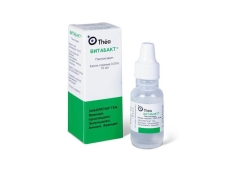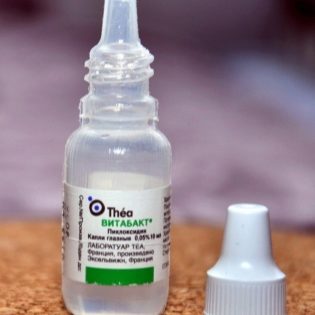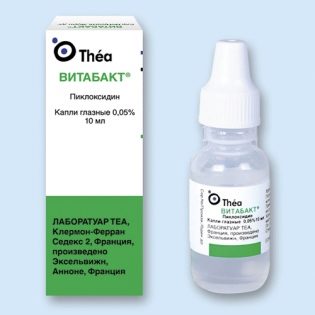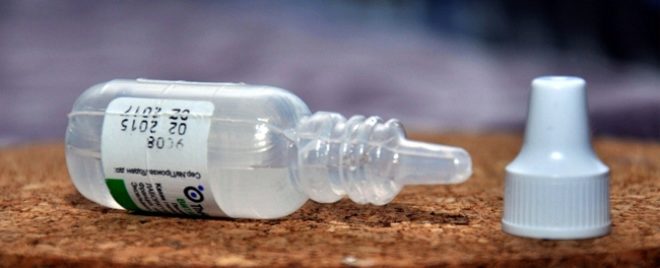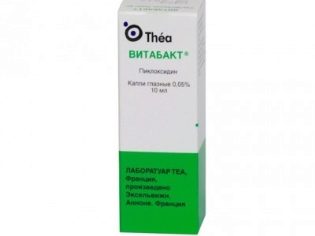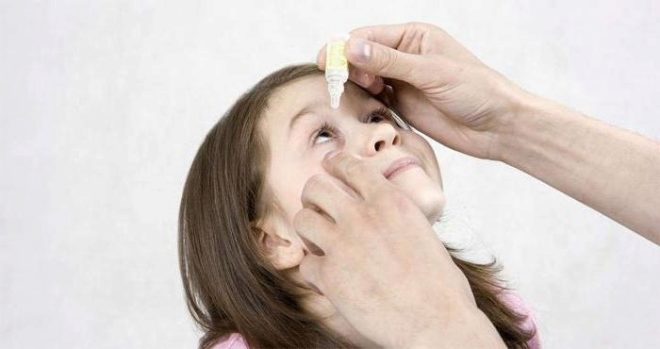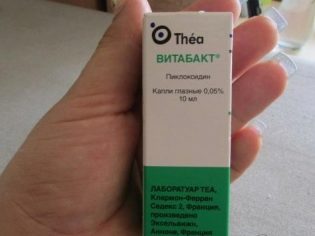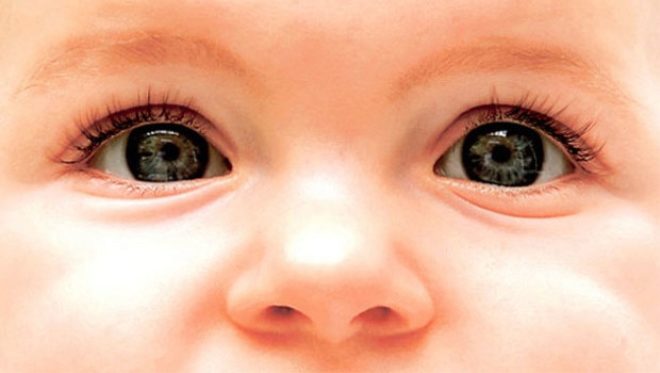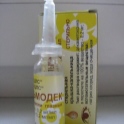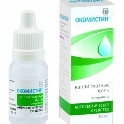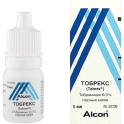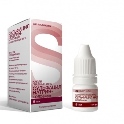Vitabak eye drops for children
For the treatment of eye diseases or the prevention of conjunctival bacterial infections, special therapeutic agents in the form of eye drops are released. One of these drugs is Vitabact. Is it possible to drip it to children when it is justified and in what dosage such a drug is used in childhood?
Release form
The drug is available in dropper bottles, which are made from plastic. Inside one such bottle contains 10 ml of clear liquid, which is often light yellow, but may be colorless. The bottle is packed in a cardboard box, inside of which there is an abstract to the drops.
Composition
The action of the droplets is ensured by the presence of picloxidin in them at a concentration of 0.05%. In 1 ml of solution, this substance in the form of dihydrochloride is contained in a dose of 500 μg. It is supplemented with anhydrous dextrose, purified water and polysorbate 80.
Operating principle
Vitabak drops have an antiseptic and antimicrobial effect. The active substance of the drug, representing the group of biguanides, affects:
- Staphylococcus aureus;
- E. coli;
- Enterococcus fecal;
- Klebsiella pneumonia;
- Proteus Vulgaris;
- Shigella dysentery;
- Chlamydia trachomatis;
- Hay stick and some other bacteria.
The drug is also active against certain types of fungi and viruses. In this case, the effect of the solution is predominantly local, and piccoxidin does not enter the general circulation.
And now we invite you to watch the video of how to drop eyes on a child.
Indications
The reason to assign a child Vitabact may be:
- Treatment of a bacterial infection that caused inflammation of the anterior eye (conjunctivitis, blepharitis, keratitis).
- Treatment of dacryocystitis, which is common in newborns and infants.
- Prevention of bacterial complications after eye surgery.
- Prevention of infection from a patient with viral conjunctivitis in case of close contact.
At what age is it allowed to take?
It is possible to dig in Vitabak’s eyes in childhood from birth.
Contraindications
The use of Vitabact drops is prohibited only in case of intolerance to picloxidin or other ingredients of the solution. There are no other restrictions in the use of this medicine in the annotation.
Side effects
In rare cases, the drug may cause conjunctival hyperemia, increased tearing, burning sensation or a foreign body in the eyes. This is how an allergic reaction to Vitabact manifests, therefore, with redness or discomfort, further use of the medication is not recommended. In addition, the use of drops can reduce the clarity of view at the time of treatment.
Instructions for use and dosage
- The packaging of Vitabakt drops (a polyethylene bottle that has a dropper) eliminates the need for additional pipetting. To open the bottle, its cap is twisted all the way, and then the thorn located inside will pierce the dropper.
- An adult must wash his hands before using the drops. If a child has abnormal secretions and crusts on the eyelashes and on the surface of the conjunctiva, first clean up. To do this, take two cotton swabs, dip them into unheated boiled water and individually wipe the baby's eyes, moving from the outside corner towards the inside.
- To drip medicine, you need to slightly tilt the child's head back so that he looked up. The solution is injected into the lower part of the eye, gently pulling down the lower eyelid. To prevent the drug from becoming contaminated, the dropper should not come into contact with either the eye or the skin of a small patient. In addition, the pipette should not be touched.
- If the medication is used to treat a bacterial infection, it is prescribed a course of 10 days, and the frequency of instillation is from 2 to 6 times a day. The pediatrician should determine the more accurate frequency of use, and a single dosage of the drug is 1 drop in each conjunctival sac.
- If the child had an operation in the eye area, Vitabact is used prophylactically. The drug is administered 1 drop 3-4 times a day. The tool is also often used before the operation - just before the intervention, 1-2 drops of the solution are injected into the conjunctival sac. If the child had close contact with a sick conjunctivitis, he can drop his eyes once immediately after such communication.
We offer to your attention the release of the transfer of Dr. Komarovsky dedicated to children's conjunctivitis.
Overdose
Information about the toxic effects of drops in an excess amount of the manufacturer does not.
Interaction with other drugs
If a child is prescribed to take several medications into the eyes at once, then there should be a break of at least 15 minutes between instillation of Vitabact and other medicines.
Terms of sale
Purchase of Vitabact drops in pharmacies is available without a prescription. The average price of one bottle of the drug is 330-340 rubles.
Storage conditions and shelf life
- Keep the drops at home should be in a place hidden from small children, where the temperature will be within + 15 + 25 degrees Celsius.
- An unopened vial can be stored for a period of 2 years.
- If during storage, flakes or any impurities become noticeable in the medicine, it should not be instilled, even if the shelf life has not expired.
- After the first use, the drug can be dripped into the eyes only for 1 month. If the first use of the medicine was more than 30 days ago, the medication should be discarded.
Reviews
In the majority of cases, parents respond positively to the treatment of children with Vitabact. The drug is praised for effective action, the ability to apply even in infants, convenient packaging. According to moms, almost all babies tolerate such a drug well, and the solution does not pinch their eyes, so babies up to a year do not respond to burying with crying and shouting.
The disadvantages of drops include their high price and a limited shelf life after opening. Also, there are reviews in which mothers point out that Vitabact was ineffective and did not help the child with dacryocystitis or barley.
Analogs
If it is impossible to use Vitabact for any reason, the pediatrician may replace it with similar medicines, for example:
- Medication Sulfacyl Sodium. This sulfa drug in drops is very popular for the prevention and treatment of eye infections. It can be used in a child of any age.
- Drops Okomistin. This antiseptic containing Miramistin is allowed to be used for bacterial conjunctivitis in children over 3 years old. The doctor may also order it to drip into your ear or nose, if there are indications for this.
- Eye drops Oftadek. The basis of this drug is antiseptic decamethoxin. These drops are allowed for children of any age and are often prescribed for conjunctivitis, even for newborns.
- Drops of Sofradex. Their composition includes antibiotics and dexamethasone. Such a drug is buried not only in the eyes, but also in the ears during otitis. It is used in children older than a year.
- Tobrex Eye Drops. It is based on the antibiotic tobramycin. The medication is prescribed from birth.
